The Pixel 5 is Google’s latest flagship phone, featuring a 6.0-inch FHD+ display, Snapdragon 765G chipset with 128 GB internal storage, 4080 mAh battery, and of course the latest Android 11 operating system. Although a flagship in the sense that it is Google’s top device, on paper its specifications are a step down from high-end competitors boasting larger displays, faster processors, and more storage. Available at just $699, however, it’s much less expensive, and Google looks to be taking aim more at the mid-range market for the Pixel 5.
The same is true for the Pixel 5’s photography specification, which features a dual-camera setup with standard-wide and ultra-wide lens options. So there’s no tele-lens for long focal length zoom shots, and no depth sensor to assist bokeh shots. It’s a switch in camera priorities over the Pixel 4’s standard-wide and tele-lens setup, and the American software giant doesn’t seem prepared to offer us a device with three different focal length lenses just yet.
For the Pixel 5, Google has stuck with the same standard-wide hardware we saw on the Pixel 4. There’s a standard-array 12.2 MP 1/2.55-inch sensor with 1.4µm pixels, coupled to a 27 mm-equivalent f/1.7 lens with dual-pixel PDAF and OIS. The wide-aperture lens should help with low-light photography, but as it eschews a larger Quad-Bayer sensor with pixel binning, Google will be relying on software and processing for improvements in noise and detail.
Opting for an ultra-wide over a tele-lens, Google has equipped the Pixel 5 with a second 16 MP 1/3.09-inch sensor with 1.0µm pixels alongside a 16.5 mm-equivalent f/2.2-aperture lens. Again, that hardware isn’t as impressive as many competitors who offer a more encompassing field of view and physically bigger chips on their ultra-wide shooters. However, it will provide Pixel shooters an alternative when they need to squeeze more into the frame.
Can Google’s advanced algorithms pull enough image quality out of the Pixel 5’s hardware to compete with its more expensive rivals? We’ve tested the phone under the latest version 4 of our Camera test protocol. Read on to find out how it performed.
Key camera specifications:
- Dual camera setup
- Primary: 12.2 MP 1/2.55″ sensor, 27 mm-equivalent (standard-wide) f/1.7-aperture lens, dual pixel PDAF, OIS
- Ultra-wide: 16 MP 1.0µm sensor, 107-degree field of view f/2.2-aperture lens
- LED flash
- 4K video, 2160p/60 fps (2160p/30 fps tested); 1080p/up to 240 fps, gyro-EIS
About DXOMARK Camera tests: For scoring and analysis in our smartphone camera reviews, DXOMARK engineers capture and evaluate over 3000 test images and more than 2.5 hours of video both in controlled lab environments and in natural indoor and outdoor scenes, using the camera’s default settings. This article is designed to highlight the most important results of our testing. For more information about the DXOMARK Camera test protocol, click here. More details on how we score smartphone cameras are available here.
Test summary
Scoring
Sub-scores and attributes included in the calculations of the global score.
Google Pixel 5


Use cases & Conditions
Use case scores indicate the product performance in specific situations. They are not included in the overall score calculations.
Outdoor
Photos & videos shot in bright light conditions (≥1000 lux)
Indoor
Photos & videos shot in good lighting conditions (≥100lux)
Lowlight
Photos & videos shot in low lighting conditions (<100 lux)
Friends & Family
Portrait and group photo & videos
With an overall DXOMARK Camera score of 120 points, the Google Pixel 5 puts in middle-ranking performance for devices evaluated under our latest testing protocol. The main camera fares slightly better with a Photo score of 129; and with key strengths for exposure, color, and autofocus, as well as well-controlled artifacts, the Pixel 5 delivers solid results for the most part.
Detail and texture are also good, but visible noise in virtually all images is a major weakness. Achieving a low-ranking score of 49 in our new Zoom category is also a little disappointing, and this affected the Pixel 5’s overall score. Ultra-wide shots are pleasant enough for exposure and color, but its limited field of view puts it at a disadvantage compared to devices that squeeze more into the frame. And if you find you often zoom in when taking smartphone snaps, then the Pixel 5 probably isn’t the device for you either. It’s surprisingly good at close range, but extend zoom further than around 2x magnification and detail starts to suffer.
The flash performs well for night portraits, and low-light landscapes are acceptable, but overall the Pixel 5’s nocturnal capabilities are nothing to write home about. Switching to Portrait mode, bokeh simulation is also respectable, rendering a pleasant effect generally, but issues with the Google algorithms produce some slightly odd effects when there’s more than one face in the frame.
The Google Pixel 5 is a very competent device shooting video, too. Its overall Video score of 107 again ranks around the middle of devices we’ve tested, but its performance is much closer to the top-tier devices. In fact, the Pixel 5 excels for video autofocus, where it sets a new top score in this category, and stabilization in 2160p/30 fps mode is very efficient as well. Videos are most successful in better lighting where exposure, color, and detail are good; but again, noise is visible in all of the Pixel 5’s movies, which is a shame. Slightly underwhelming exposure and obvious color casts are also visible in low light, but if you can seek out some brighter conditions when shooting video with the Pixel 5, you won’t have too many complaints.
Photo scores explained
The Google Pixel 5 achieves a Photo score of 129 points, putting it in the second tier of devices we’ve tested recently. The Photo score is calculated from sub-scores in tests that examine different aspects of a device’s performance for still images under different lighting conditions. In this section, we take a closer look at how these sub-scores were determined and compare image quality against some key competitors.

Exposure and Contrast
Google Pixel 5
96
111
Exposure is a main strength for the Pixel 5, with excellent scores indoors and outdoors, as well as good results in low light. Target exposures are slightly low in our lab measurements, but hovering around 45L*, they stay just within our acceptable threshold in all lighting conditions. Measurements are lower than some competitors (as you can see in the chart below), but the Pixel 5 has improved in very low light compared to the Pixel 4.
In our perceptual analysis, exposures scores weren’t quite as impressive, but still good. Target exposures are mostly accurate, but there’s a specific issue in portraits, which are often underexposed. In this challenging HDR backlit portrait, for example, portrait exposure is very low, with the iPhone and particularly the Xiaomi able to produce a brighter representation of the subject.
Dynamic range on the Pixel 5 is also good, but again, slightly behind top performers such as the P40 Pro and the Mi 10 Ultra. In our backlit group scene, more highlights are clipped on the Pixel 5, and target exposure is again low. To be fair, the Pixel 5 does avoid the tone compression that is clearly visible on the Huawei and Xiaomi devices, but it has fewer details in the shadows and highlights.

Color
Google Pixel 5
96
107
The Pixel 5 achieves a good score for color, with pleasant and accurate rendering in most tested conditions, although there’s slight room for improvement in low light. The device achieved excellent scores in indoor and outdoor scenes, where accurate white balance and nice rendering ensure generally vibrant color and pleasant skin tones. In low light, saturation remains good, but our testers found white balance can be a little slightly unstable under artificial light sources. In this outdoor scene, you can see that the white balance is slightly warmer on the Pixel 5 compared to the iPhone and Xiaomi, but the effect is nice, with rich color and accurate skin tones.

Autofocus
Google Pixel 5
98
109
Another excellent set of results for the Pixel 5 in the autofocus category, where it’s close to the top-performing devices. We observed no failures in any lighting conditions in our benchmark lab testing, with the Pixel 5 snapping images sharp every time. It’s fast, too, with generally minimal delay for the device to find focus, even under challenging HDR setups. The only slight exception is in very low light (5 lux), where we observed some irregularities and slower reaction times on handheld shots, but again, they were always in sharp focus… eventually. Under indoor conditions, though, it’s super fast and accurate, as the chart below illustrates.
Depth of field is also very long on the Pixel 5. In our group portrait scenes, as well as on backgrounds generally, we found the Google device produced sharper, more detailed results on elements towards the back of the image compared to many competitors.

Texture
Google Pixel 5
98
111

Noise
Google Pixel 5
65
102
The Pixel 5’s scores for texture are good, although there’s some room for improvement in low light, and noise control is one of its main weaknesses. Google has managed to significantly improve in detail over the Pixel 4 when using a tripod in very low light, and the Pixel 5 is able to maintain high acutance scores over 80% in all lighting conditions. Texture scores are good in handheld shots under simulated indoor and outdoor lighting conditions, too. Expect a dip in detail preservation in handheld low-light shots, though, where the Google device isn’t quite as adept as our top performers.
We found detail to be very acceptable in most cases when shooting natural scenes. At close inspection, the Pixel’s 12.2 MP sensor is comparable to other devices that utilize similar sensor technologies (such as the iPhone 11), but it doesn’t quite compete with pixel-binning sensors on competitors such as the Mi 10 Ultra, which can extract greater fine detail.
The absence of a Quad-Bayer sensor also has a significant impact on noise, which is one of the Pixel 5’s main weaknesses. Noise is visible in every lighting condition, and especially in the dark areas in natural scenes. In our lab analyses, we found noise to be reasonably well controlled under good to fair lighting, and there’s been a noticeable improvement over the Pixel 4. But the Pixel 5 remains behind top performers such as the Mi 10 Ultra in low light.
The high noise level is particularly prevalent in darker areas in HDR and backlit scenes. In the scene below, the Huawei provides a brighter exposure and significantly lower noise for the dark skin tones compared to the Pixel 5. It’s true that Google has improved noise performance considerably over the Pixel 4 thanks to better signal processing, but there’s still some ways to go compared to the best.

Artifacts
Google Pixel 5
73
77
Control of unwanted artifacts is a good strength for the Pixel 5. The main issue we observed was color fringing, which is slightly visible in all outdoor shots, with heavy purple fringing evident along contrast edges in bright backlit scenes. We also applied some smaller point deductions for some ringing, ghosting, moiré patterns, and loss of acutance in the outer field, but overall the Pixel 5 controls artifacts very well.

Bokeh
Google Pixel 5
60
80
A respectable score for bokeh, and despite the lack of a dedicated ToF sensor to help improve depth estimation, the Google algorithms do a reasonable job on the Pixel 5. Rendering is pleasant for the most part, with a strong blur intensity, circular spotlights, and uniform noise; and performance is reliable, with the effect applied when requested. Depth estimation isn’t perfect, though, with slight edge artifacts often visible around the subject. There’s also some strange behavior in group portraits, where the Pixel 5 algorithms detect all faces and blur around them. So with multiple people in the scene all faces are sharp regardless of their position, which isn’t very natural and looks a little odd.

Night
Google Pixel 5
60
82
The Google Pixel 5 racks up a solid set of results in our perceptual analysis of night scenes, without really breaking any new ground for after-dark photography. Shooting low-light cityscapes with the flash off, exposures and color are generally accurate, as long as there’s plenty of artificial lighting for the Pixel 5 to work with. In very low light, though, results aren’t very impressive, with low target exposures and detail, as well as very visible noise and some color quantization. When flash activates, target exposure and skin tones are accurate. Dynamic range is very limited, though, so backgrounds are often very underexposed, which creates a rather stark portrait shot overall, and the red-eye effect is often visible.

Preview
Google Pixel 5
56
80
You can expect a fairly reliable performance from the Pixel 5’s preview image, with an accurate representation of exposure in most conditions. Performance is good both outdoors and indoors, where some live HDR processing ensures that highlights are reasonably well controlled, and generally the final image is similar to the preview. There’s some room for improvement in low light, however, where the final photo is often much better than the preview suggested, especially for color, noise, and texture.
Bokeh rendering is a major drawback for preview performance on the Pixel 5, however, with the simulated effect never activating during our tests.
Zoom scores explained
The Google Pixel 5 achieves a Zoom score of 49 points. Despite a generally good performance up to this point, Google’s latest device really starts to struggle against the top performers when it comes to zoom. In this section, we take a closer look at the device’s tele and ultra-wide sub-scores and compare its zoom image quality against some key competitors.

Tele
Google Pixel 5
57
140
Unsurprisingly, without a longer focal length tele-lens, this is a main area of weakness for the Pixel 5. On the plus side, exposure and color are accurate in all zoom shots and good computational photography ensures acceptable results at close range. That said, detail is still slightly low and noise is visible in all zoom shots. While results at longer zoom ranges are slightly better than those of some competitors with similar lens hardware, such as the iPhone 11, the Pixel 5 is far behind the best performers for medium- and long-range shots, such as the Mi 10 Ultra.

Wide
Google Pixel 5
38
58
Switching to the dedicated ultra-wide camera, Pixel 5 images display good exposure and color rendering, although slight white balance casts are visible in all tested conditions. Detail is lower compared to the main camera, and again noise is usually visible. There are also problems in the outer field, with a loss of sharpness and errors in anamorphosis and geometric distortion correction. For the most part, though, these issues don’t significantly undermine the overall pleasantness of ultra-wide shots. Its main disadvantage is its field of view, which we measured at 16.5mm. As you can see from the examples below, the Pixel 5 doesn’t fit nearly as much into the frame as devices like the iPhone 11 and the Mi 10 Ultra.
Video scores explained
Tested in 2160p/30 fps mode that offers the best quality for video with stabilization available, the Google Pixel 5 achieves an overall Video score of 107. That ranks Google’s latest device slightly better for moving images compared to stills, with performance showing a couple of key strengths as well as some areas for improvement. The Pixel 5’s overall Video score is derived from its performance and results across a range of attributes in the same way as the Photo score: Exposure (86), Color (91), Autofocus (105), Texture (82), Noise (79), Artifacts (79), and Stabilization (99).
Overall video exposure on the Pixel 5 doesn’t quite compete with the best devices we’ve tested, but target exposures are mainly accurate in good to fair lighting conditions, so you can be confident of nice, bright movies in indoor and outdoor scenes. Dynamic range is a little limited, so expect some highlight clipping and darker target exposures in high-contrast conditions; and videos tend to be underexposed in low light, but for the most part you won’t have too many complaints for video exposure.
The same is true for video color, with generally good results indoors and outdoors, but a couple of niggles in low light. Colors are vivid in nice lighting conditions, and aside from an occasional pinkish color cast outdoors and an orange tint indoors, white balance remains fairly neutral. White balance is inaccurate in low light, however, where a strong orange cast is often visible under artificial lighting.
Like with stills, the Pixel 5 could manage its texture/noise trade off a little better. While detail in 4K files is very good under indoor (100 lux) and outdoor (1000 lux) conditions, texture rendering drops off quickly in lower lighting, with measurements down to around 50% acutance at 5 lux in our lab analysis.
The level of noise is also high in all conditions, and while it’s less distracting in outdoor movies, expect to be aware of high levels of digital interference when playing back indoor and low-light videos from the Pixel 5.
Where the Pixel 5 excels for video performance is autofocus, becoming our new top-ranked device for this attribute. Autofocus scores and measurements were excellent in all lighting conditions, and with fast response times, excellent tracking, accuracy, adaptation, and stability, you can be confident of sharp movies from Google’s latest device.
Stabilization is very efficient, too, which is especially true in outdoor walking and panning videos. It’s good indoors as well, with walking motions well compensated for. We noticed the odd frame shift in all lighting conditions, some ghosting in low light, and a little judder in panning videos at 30 fps, but these are minor quibbles in an otherwise stellar performance for autofocus and stabilization.
Conclusion
Google has changed tack with the Pixel 5 and set sail for the mid-range market with a lower-specification model that’s more affordable than top-end devices from competing brands. Whether that decision has a significant impact on your overall phone experience remains to be seen, but it does impact photography performance and the Pixel 5’s DXOMARK Camera ranking.
With limited hardware, the Pixel 5 stands behind top performers for attributes such as texture, noise, bokeh, and zoom, where extra sensors and lenses really help. That said, its main camera delivers nice images, with the Google device delivering close to top scores for the basics of exposure, color, and autofocus. So we have few complaints about the standard-wide camera (aside from noise, perhaps), and compared to similar dual-camera devices, the Pixel 5 holds its own, thanks to its impressive software power. What’s more, it delivers pleasant video, with particularly impressive autofocus and stabilization, making the Google Pixel 5 a competent device for smartphone photography that doesn’t break the bank.
Pros
- Fast and accurate autofocus (Photo & Video)
- Bright and vivid color (Photo & Video)
- Accurate white balance in outdoor photos
- Mainly accurate target exposure (Photo & Video)
- Effective video stabilization
- Good exposure in ultra-wide photos
- Nice exposure in flash portrait photos
- Reliable preview image for exposure (Photo)
Cons
- Low target exposure in some portraits
- Visible noise in all conditions (Photo & Video)
- White balance errors in low light (Photo & Video)
- Color fringing in outdoor photos
- Inaccurate depth estimation in bokeh photos
- No bokeh effect visible in preview (Photo)
- Low detail in zoom photos
- Low detail and ghosting in low-light videos
- Frame shifts in all videos


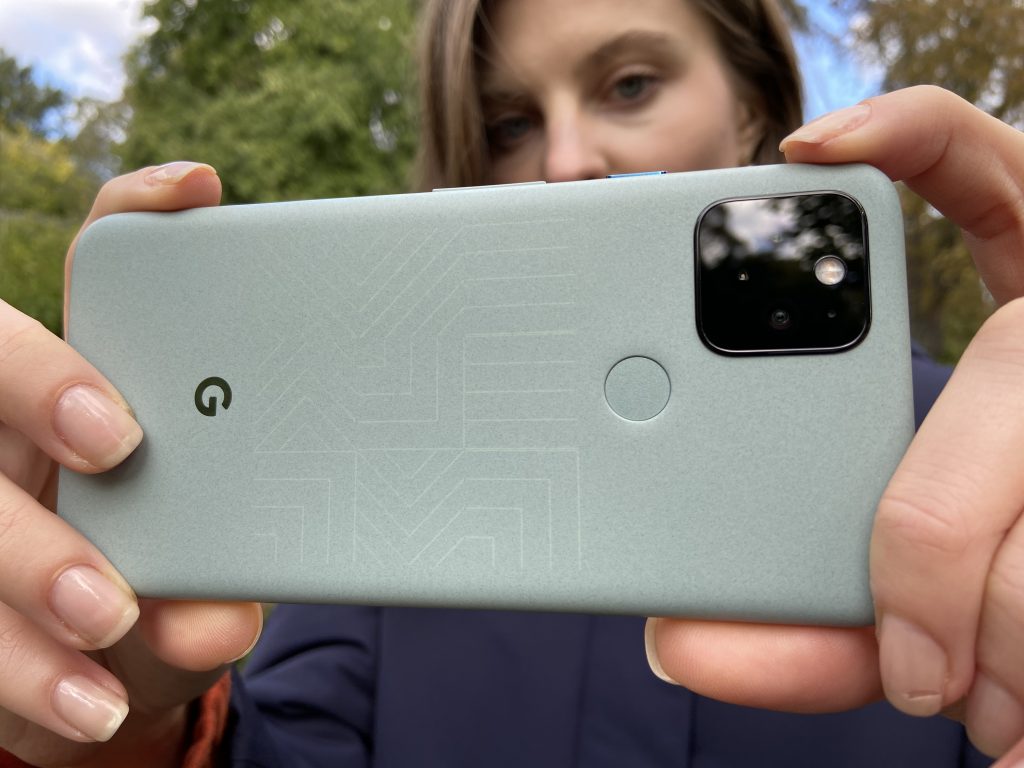
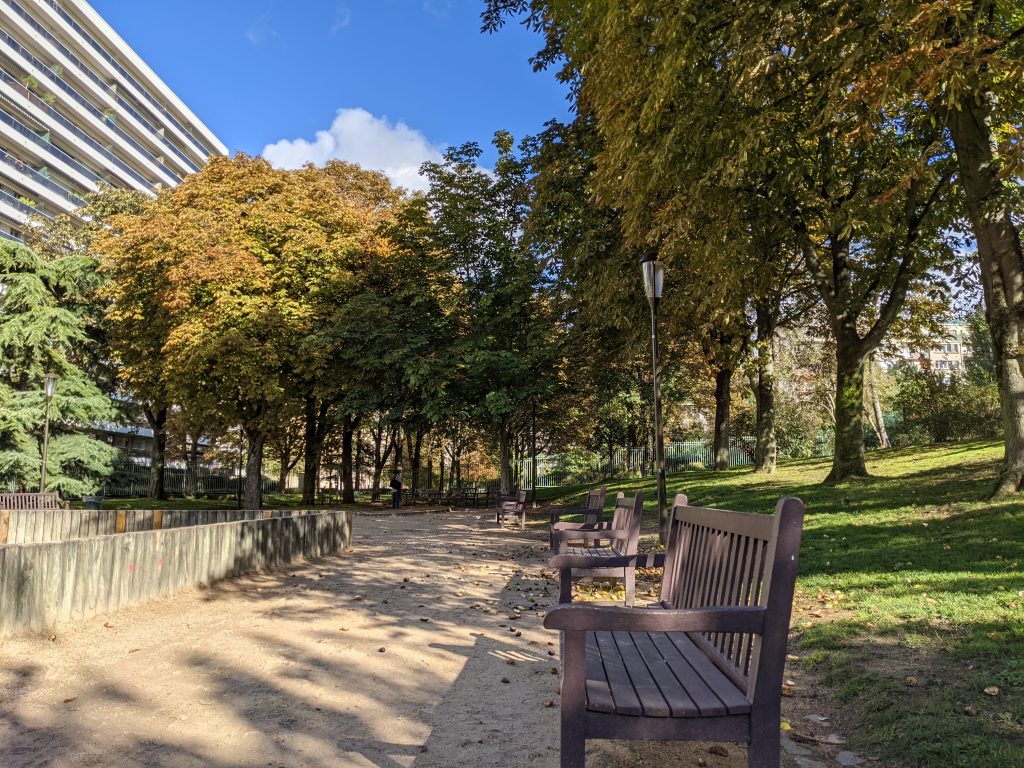
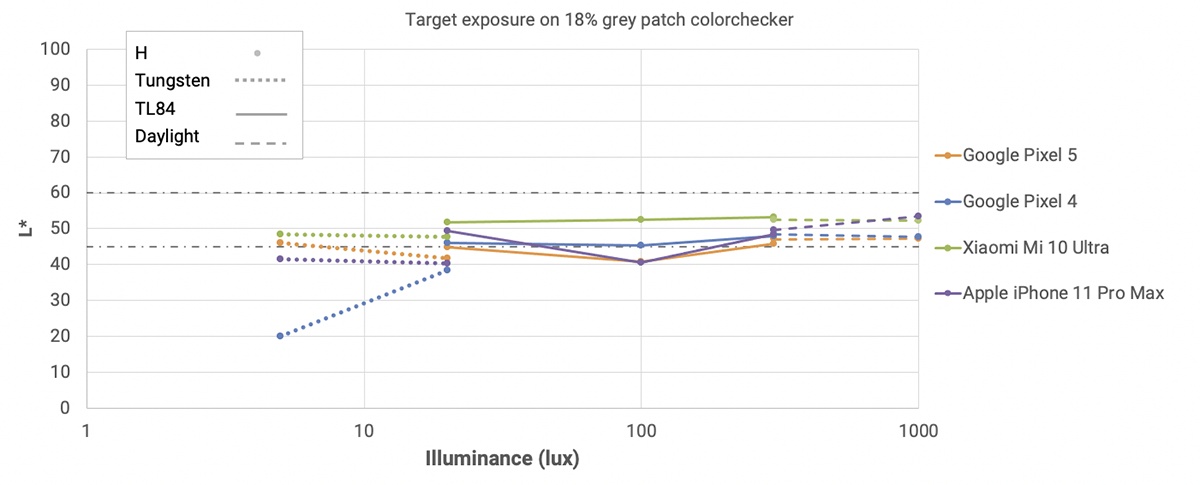
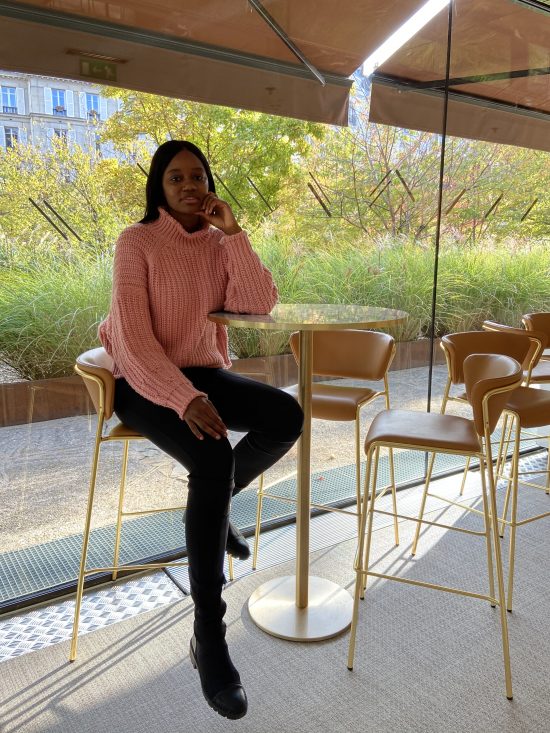
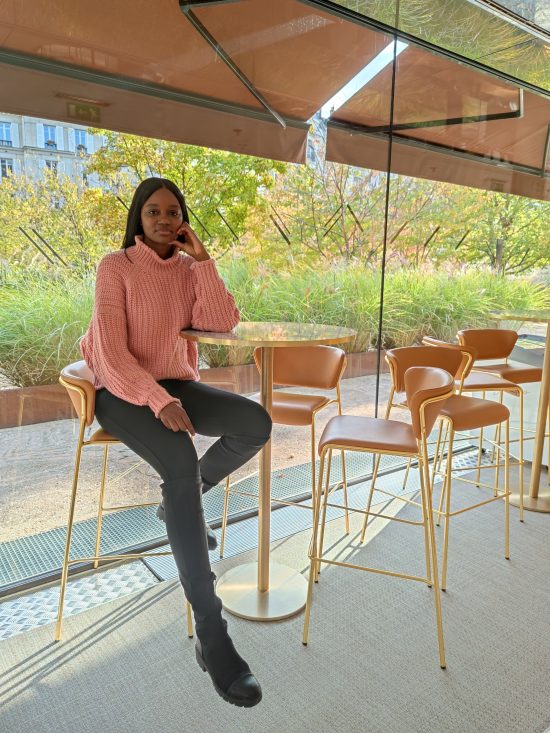


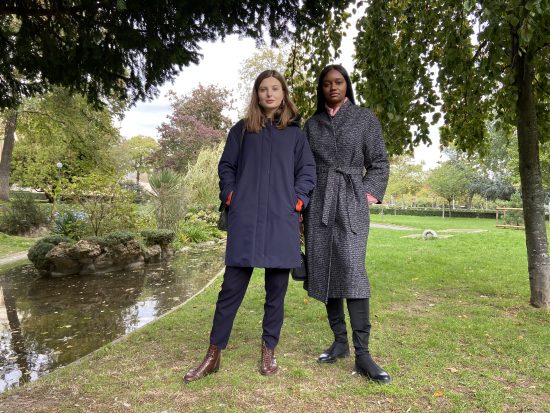
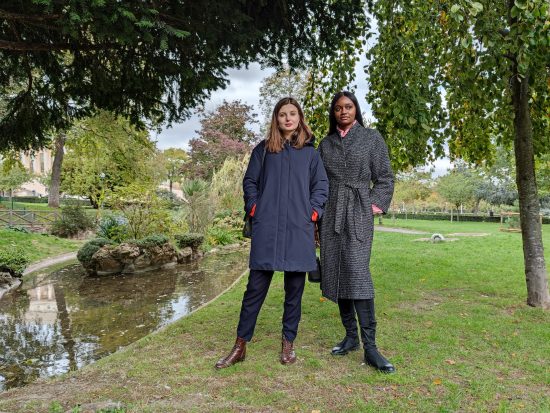
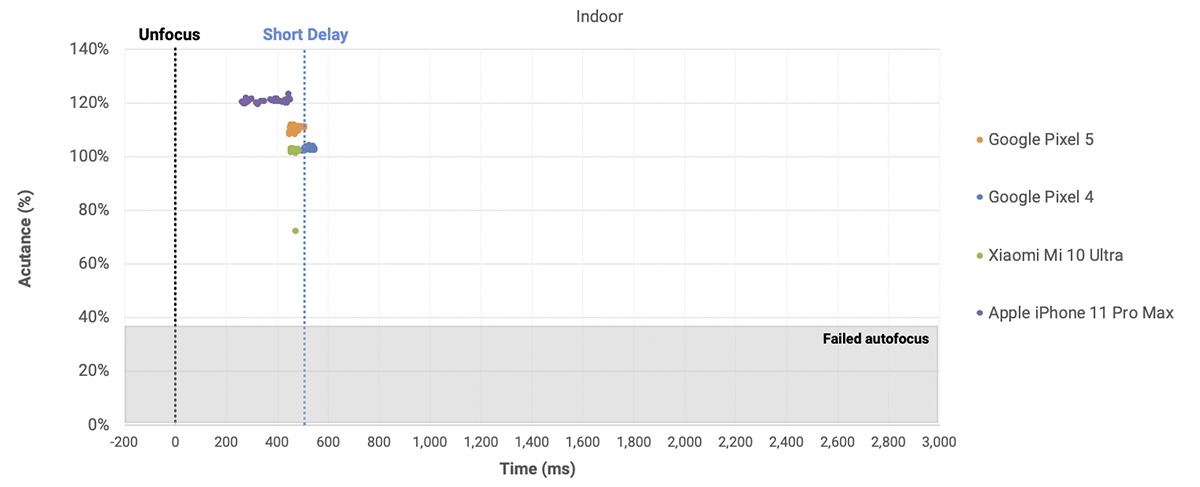

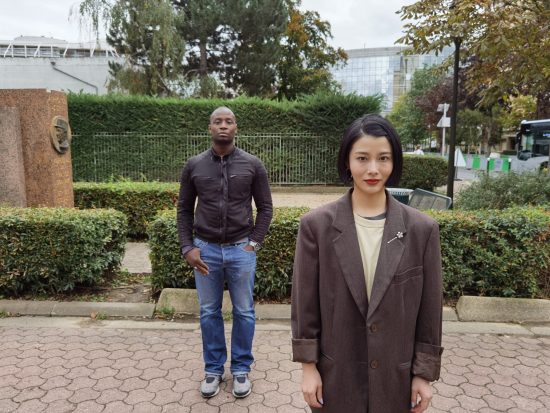
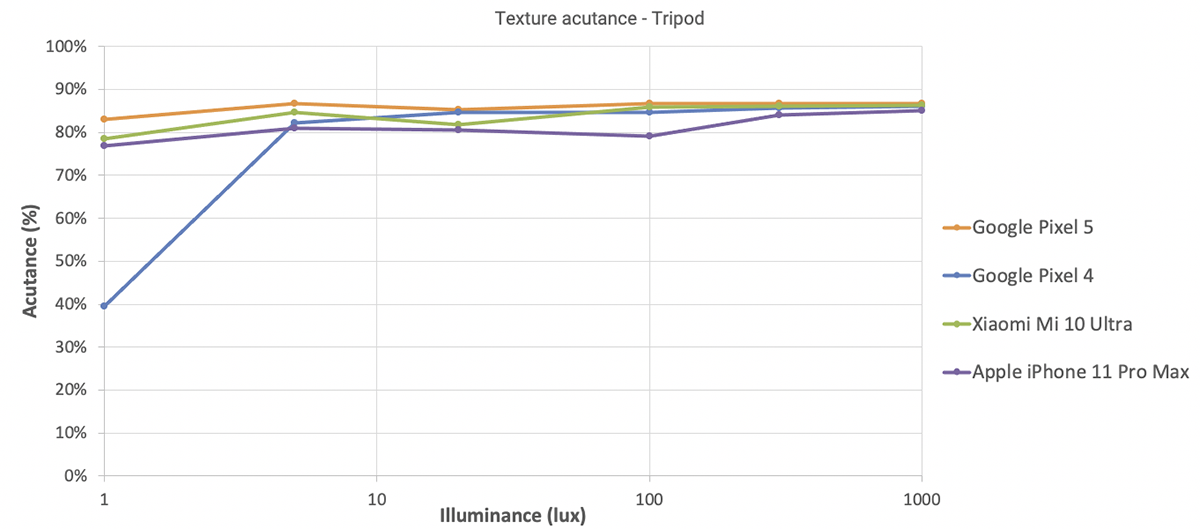


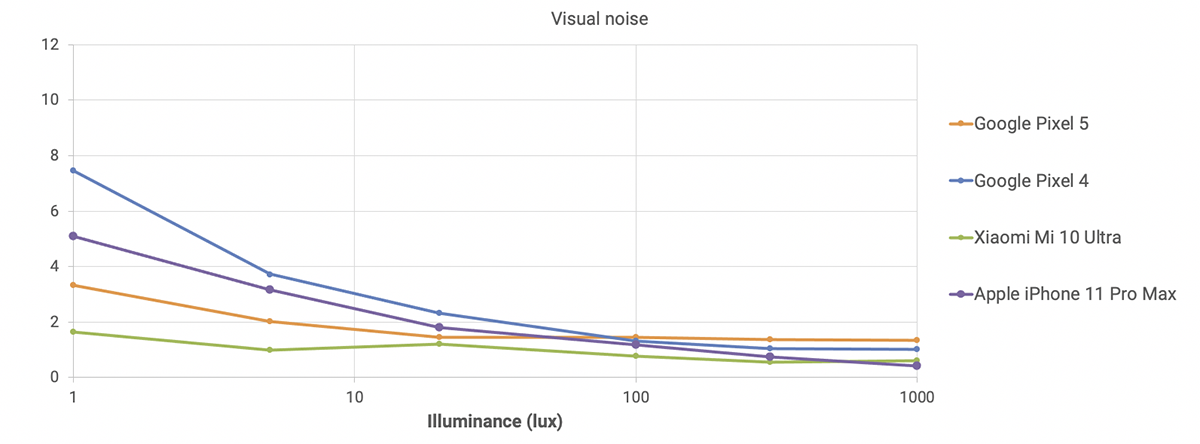


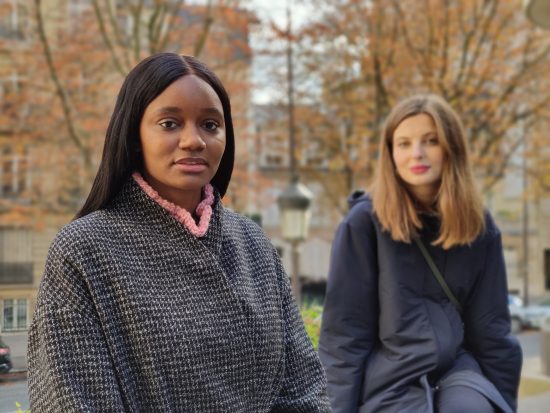

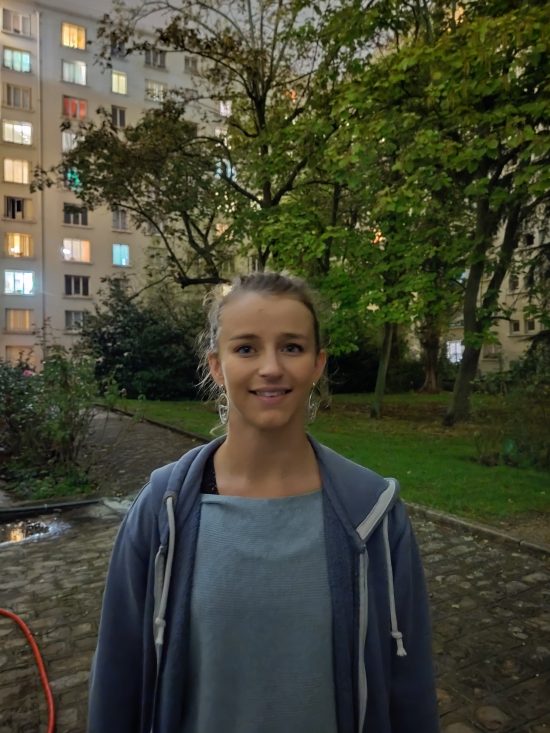




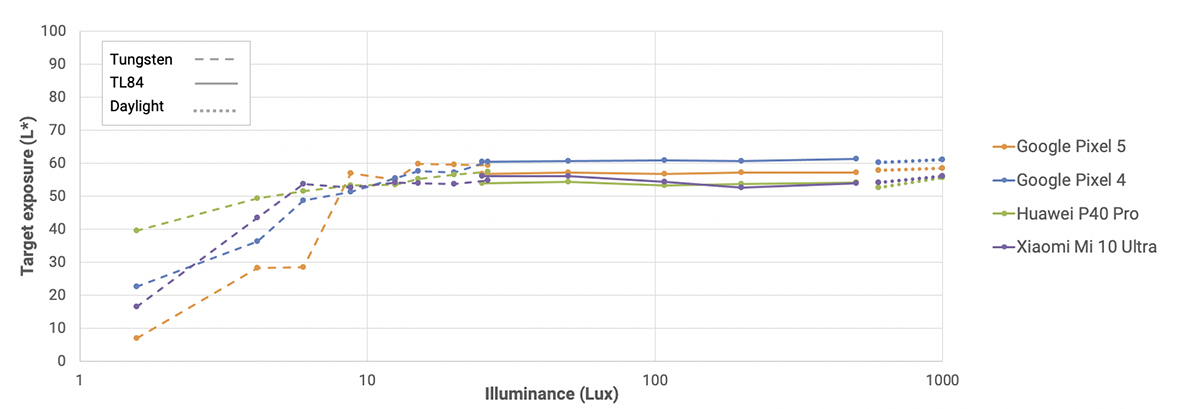
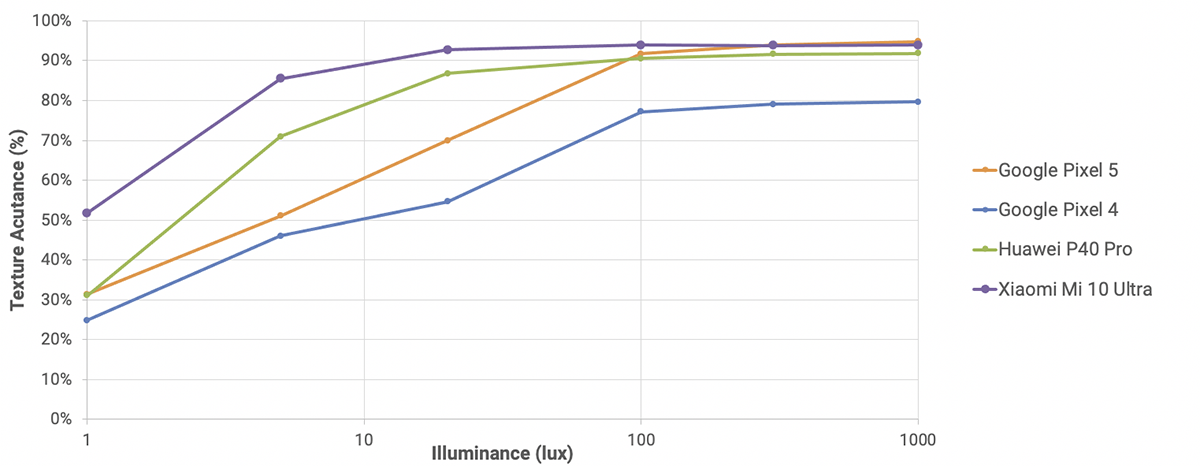
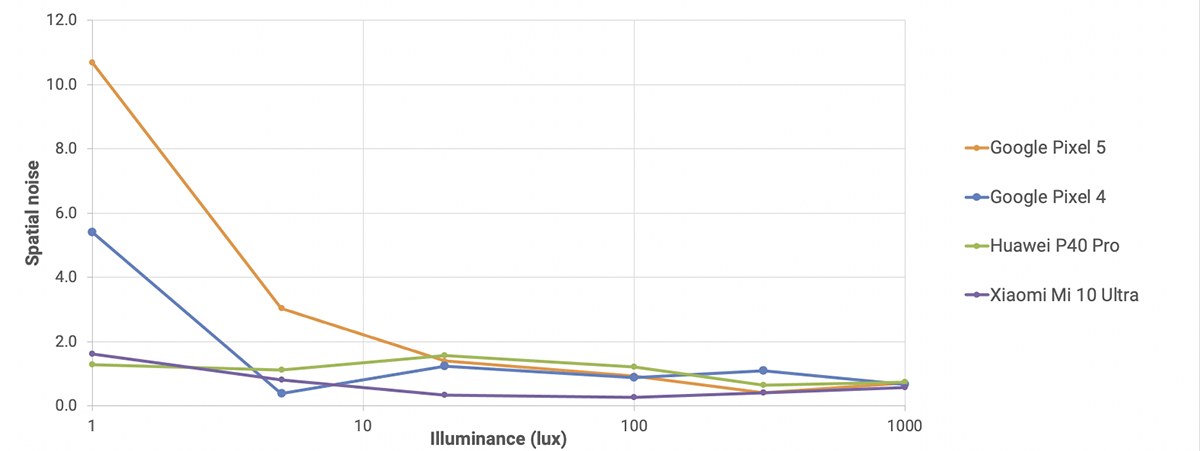

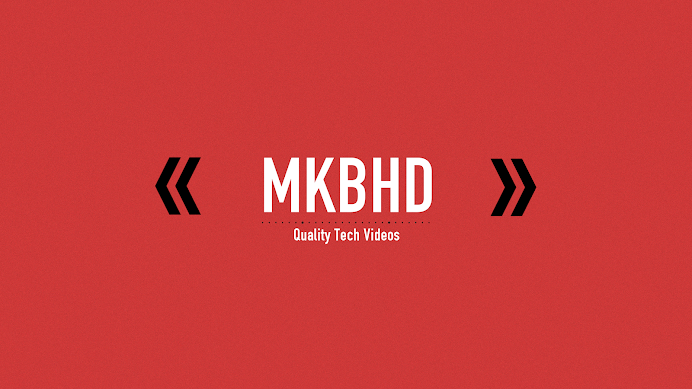
DXOMARK encourages its readers to share comments on the articles. To read or post comments, Disqus cookies are required. Change your Cookies Preferences and read more about our Comment Policy.